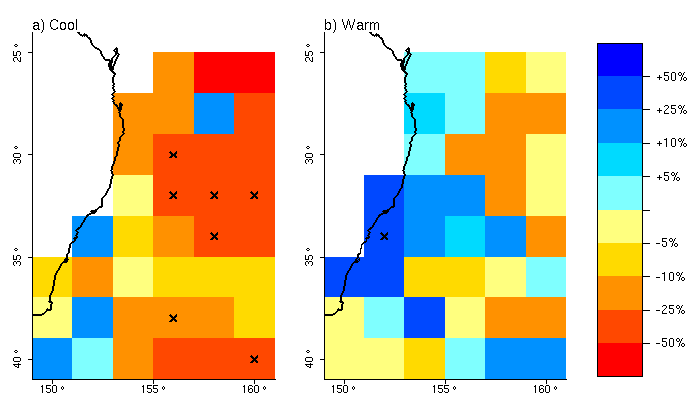One of the things I'd like to get better at is using this blog to promote/discuss recent research I've published. So, today I'm going to talk about a paper I have in press at GRL.
As I've spoken about before, East Coast Lows are one of the main causes of severe weather along the east coast of Australia, as well as being very important to our long-term water security. So there is a lot of interest in whether these storms will change with global warming over the coming century. Broad-scale study of storm tracks across the globe, as well as recent work looking at ECL-favourable conditions in the upper atmosphere, suggest that they will probably decrease in frequency.
But these studies all focused on the big picture, and haven't looked at how the individual storms will change, especially the small and short-lived storms that can develop overnight. My paper is different in a couple of ways:
As I've spoken about before, East Coast Lows are one of the main causes of severe weather along the east coast of Australia, as well as being very important to our long-term water security. So there is a lot of interest in whether these storms will change with global warming over the coming century. Broad-scale study of storm tracks across the globe, as well as recent work looking at ECL-favourable conditions in the upper atmosphere, suggest that they will probably decrease in frequency.
But these studies all focused on the big picture, and haven't looked at how the individual storms will change, especially the small and short-lived storms that can develop overnight. My paper is different in a couple of ways:
- Instead of global climate models, I used regional climate models, which give higher-resolution data and are better able to identify individual lows
- Instead of just one method of tracking cyclones, I used three, at multiple resolutions - this is important because all computer programs to identify cyclones identify slightly different things
- I used two methods that identify individual cyclones, making it possible to look at changes in the location and impacts of cyclones for the first time
So, what were my results?
- Winter ECLs are likely to decrease in the future, consistent with previous studies
- There are larger uncertainties for summer ECLs and ECLs close to the coast - these may actually become MORE frequent
- Even though winter cyclones are likely to decline, there may be an increase in cyclones with heavy rain in both seasons
What's next?
The regional models still had issues with getting the correct seasonality of ECLs, and I want to increase our understanding of why the models do what they do:
The regional models still had issues with getting the correct seasonality of ECLs, and I want to increase our understanding of why the models do what they do:
- Could the different changes along the coast be related to the impact of the East Australian Current? How does it influence cyclones anyway?
- Why are the trends different in the different seasons - is it related to different types of ECLs?
- Why do the models have too few cyclones in the cool season and directly near the coast - could it be something wrong in the topography?

 RSS Feed
RSS Feed
